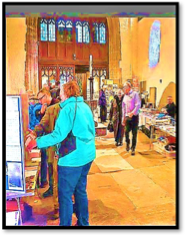
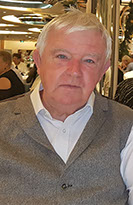
David Mills
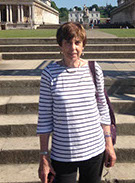
David Mills and Sue Allen report on the 2017 Chartist Convention
DAVID MILLS (Gelligaer Historical Society) REPORTS on a day when for the second time in the eleven years of its existence, Newport’s Chartist Convention was warmly welcomed by the Dean to the impressive and evocative surroundings of Newport Cathedral (St. Woolos).
He admitted that in the days of the Chartists, the Church had not been so friendly towards them and their democratic political demands. How times change!
At six o’clock, the Convention over, people assembled in the churchyard as they have done for more than 30 years on November 4th. This was the day in 1839 when more than twenty Chartists were killed and fifty were wounded by soldiers of the 45th Regiment positioned inside the Westgate Inn, Newport. Following perfunctory inquests on ten bodies, kept in the inn’s stables, they were removed to the parish churchyard and buried on the north side of St. Woolos in unmarked graves. The church register records ten men, names unknown who were shot by the 45th Regiment.
In the St. Mary’s ‘Galilee’ Chapel at the western end of the Cathedral, local history societies and enthusiasts, displayed their ‘wares’ and publications.
The theme of the day was the ‘disturbances’ of the 1830s and 1840s across Severnside and the Bristol Channel, notably the challenges faced by the authorities in 1831 at Bristol, Newport and Merthyr and by ‘Rebecca’ 1839-4.
The common thread running through the day’s presentations was a refusal to accept that these “disturbances” involved wanton destruction or were caused by drunken behaviour. They were deliberate acts carried out by aggrieved communities responding to both the action and inaction of the Government, local gentry, and employers.
This was the first time at the convention for SUE ALLEN, a fellow member of the Gelligaer Historical Society. She was delighted with the day. "A great opportunity to meet people from other societies. People were here from all over the country. It gave me a chance to catch up on some of the latest research. It’s only in recent times that I have started paying attention to the history of the 1839 Rising. This was as a result of meeting up again, decades later, with Les James, a fellow student from university days."
Sue grew up in Pontllanfraith near Blackwood - a hotbed of Chartism in 1839. "And I was told as a child that the Chartists met at the Coach and Horses Inn in Blackwood and the Greyhound in Pontllanfraith and they marched on Newport led by John Frost. That was as much as I gleaned."
After studying at University College, Sue continued living and teaching in London. She taught A level History but the text books had little to say about the Newport Rising and the focus was always on Feargus O’Connor.
It was through research of her FAMILY HISTORY in later life that Sue Allen entered the world of South Wales Chartism. From two cousins, she discovered two separate stories passed down the generations revealing family links with the Chartists. "One was my great-great-great grandfather, Reverend Morgan Morgan, the radical minister of Bethlehem Congregational Chapel, Blaenavon. The story is told that he was present at the Bristol Riots and when the troops were about to fire, a cry went out 'Will all those who can read and write take one step back’. . He was one of a group of Nonconformist Ministers in the Trevethin area who petitioned Parliament after the Great Reform Act for the abolition of church rates. Also, known to be a Chartist sympathiser, a subscription form to a Chartist Lodge (now sadly mislaid) was found amongst his papers."
"The other Chartist story sheds a different light on things. On the night of 3rd- 4th November 1839, Chartists paid visits to outlying farms. One such farm was Brynyscawen Farm in the parish of Mynyddislwyn lying on the mountain above Ynysddu and the Sirhowy Tramroad. They knocked on the farm door of another 3g-grandfather, Watkin Rees. They urged him to join the march on Newport. When he declined they threatened him as to what they might do on their victorious return. His daughter Margaret, nine years of age at the time, was extremely frightened by this incident."
Notes from the Day’s Lectures – compiled by SUE ALLEN:
ROGER BALL (Bristol Radical History Group) spoke about the weekend of 29th to 31st October 1831. The riots were a response to the defeat of the second Reform Bill in October 1831. They were triggered by the visit of the City’s recorder, Sir Charles Wetherall, a strong anti-Reformer, heavily protected by troops and special constables. The rioting escalated when a rioter was shot dead.
The contemporary press depicted what happened as “mindless vandalism”. Roger Ball argued that this was not the case, pointing to evidence of coordinated and targeted action. Importantly, no working class or middling houses were touched and the wealthy were not killed. The crowds focussed their attacks on three prisons (symbols of oppression) with liberation of the inmates. The Mansion House (representing civic power) and the Bishops Palace (ecclesiastical abuse) were burnt, but the crowd spared the Cathedral, presumably considered public space. The Custom House, the Excise Office and the Tollhouses were destroyed. Queens Square, the wealthiest area of the city, was ransacked.
In spite of instances of violence, drunkenness and debauchery, Roger Ball made it clear that this was not a random outburst of violence but a strategic attack on symbols of corruption and the abuse of power in Bristol such as the corporation and the magistrates, the merchants and the clergy. The reaction of the Dragoon Guards was ferocious. 800 people were wounded or killed.
LES JAMES (co-editor, CHARTISM e-MAG)* argued that the roots of the 1839 Rising are to be found in the events of 1831 – at Merthyr in June and at Bristol in October. The recent discovery of the original letter written by Zephaniah Williams admitting a planned insurrection in 1839 confirms that Ivor Wilks was quite justified in his claim that “any attempt to reconstruct the rebel design must depend heavily though by no means exclusively on it.” (p148, 1984)
The Merthyr disturbances (named a ‘Rising’ by Gwyn Alf Williams) began as a local response to economic grievances, developed political demands and petered out within a week due to lack of organisation. It nonetheless germinated insurrectionary aspirations across the south Wales coalfield, which came to naught that November 1831 in the wake of the ruthless military repression of the Bristol protestors. Nevertheless, the heroic memory of the men of Merthyr keeping the military at bay for nearly a week in June did take hold upon the Welsh imagination and over the decade that followed, the idea of a ‘break out’ strategy emerged . In their south Wales lodges, the Chartists planned a ‘Rising’ that aimed to secure the coalfield as a demilitarised zone, neutralise military control in surrounding towns and generate uprising in the west of England, spreading to London. Such aspirations were the product of a society where electoral politics did not exist. The two county seats were shared between the nominees of two powerful landed families – Morgans and Beauforts – until at least 1831.
As the leading coal trading port in south Wales, Newport shared the coalfield’s economic fortunes and discontents - high taxes, income reduction, heavy indebtedness and economic depression in 1831. But in contrast, unrest at Newport 1830-32 was channelled through borough politics and for the first time in at least a century, electoral politics came alive in the town. John Frost, a radical draper and a ‘son of the borough’, had championed the rights of the burgesses of Newport for over 20 years. Unlike Cardiff and Monmouth, where Bute and Beaufort kept a tight rein on civic activities, the Morgans were fast losing control in Newport. The number of voters was small, but with open voting, they were subject to pressure from new neighbours who owed no loyalty to the Tredegar estate. Debt dominated the lives of employers and workers. The wharves at Newport were silent in 1830.
Frost appreciated the fluid nature of public affairs that opened up in the wake of revolution in France deposing Bourbon rule. He intervened at a meeting organised by Thomas Prothero, the Tredegar estate’s agent, at the King’s Head (Dec 1830). Sir Charles Morgan gained luke-warm support from the local business community for his proposals to fund special constables and administer harsh treatment for rick burners. When the House of Lords rejected the Reform Bill, Frost saw his opportunity to build in the following elections of 1831 and 1832, a popular anti-Tory alliance behind a pair of Reform Whigs, who forced Sir Charles to give way on his county seat and caused the son of the Duke of Beaufort to lose the Boroughs seat.
This alliance of convenience lasted until 1832, for unlike at Merthyr and Bristol, the middle classes of Newport did not urge the military to get involved, even though the army did make two brief appearances in the town, both not without incident. The Whig newspapers of Bristol, Monmouth and Swansea managed the news to their political advantage. They reported crowds gathering at Newport Bridge and St. Woolos to view the fires of the Bristol riots. They ignored the crowd’s vigorous attempt to blockade the Bristol packet at Rodney wharf and prevent embarkment of the 11th Regiment of Foot for Bristol. We know this happened because Lieutenant Colonel Love reported his difficulties at Newport to the Home Office. Further evidence of vociferous protest can be discerned in the press. There was incendiary action on the outskirts, night time protests within the town, with a rick set alight behind a beer house in Llanarth Street during the weekend, when the return of the 11th was expected. The barn at Llantarnam Abbey, property of the father of Reginald Blewitt MP, was burned down. When they did return, the 11th Dragoons were hooted.
The town’s radicals were punching well above their weight. Frost and his cohorts turned street demonstration into a theatrical ‘art form’ that held sway in Newport until May 1839.*
The final talk was by RAY STROUD ** on the fate of ‘The Chartist Scarecrows’, a name ascribed to them by Feargus O’Connor, who sought through the pages of the Northern Star to bring their dreadful plight to the public’s attention. These were the five Chartists who were convicted of High Treason, pleaded guilty and sentenced to death but immediately commuted to life and then reduced to five years. They were Jenkin Morgan, a milkman of Pillgwenlly, John Lovell, a Newport gardener, Richard Benfield, a miner of Sirhowy, John Rees a miner of Tredegar and Charles Waters a ship’s carpenter of Newport. They were incarcerated in Millbank Prison, London. Ray Stroud graphically described what the regime at Millbank was like…very damp so inmates were vulnerable to cholera. It was near the River Thames and therefore unhealthy. Endless hours spent on the treadmill. They endured the separate system which kept prisoners in isolation. Their day was spent picking oakum, making mailbags and turning the crank – food was dependent on the number of turns they completed. This very well illustrated talk, also focussed on the environment of Jenkin Morgan in Pillgwenlly, an area prone to flooding and over-run with beer houses.
** SEE ARTICLE 7 In Search of Jenkin Morgan (Ray Stroud) in this edition of CHARTISM e-MAG
Before the day’s programme began, Jeremy Knight treated the audience to a brief tour of the Cathedral
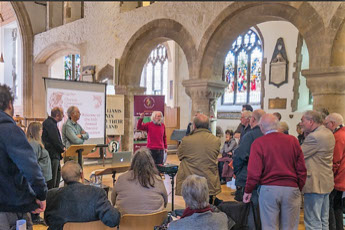
Jeremy Knight
Photos: Gareth Croft
Photos: Gareth Croft
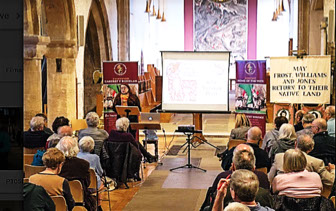
Sue Allen
